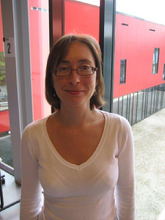Directional wetting on patterned surfaces
Promotion date: 7. July 2011
Promotor: Prof. dr. ir Bene Poelsema
Co-promotor: Dr. Stefan Kooij
| In this work, anisotropic patterns are chosen consisting of stripes of alternating wettability. The patterns on the surface are created using lithographical skills. The stripes are hydrophilic and hydrophobic for the liquids studied. A static shape of droplets can typically be approximated by a cylinder with two hemispherical caps. The spreading process is studied using a high-speed camera. The motion of droplets over various patterned surfaces is studied and discussed. The droplets can move, only ‘driven’ by the surface pattern chosen, over large distances, allowing strategies for applications, for example antiwetting coatings on nozzle plates to remove unwanted ink wetting. |
Was your research of a fundamental character or more application driven?
My thesis concerns a topic studied in physics for a long time already: surface wetting. By using lithography techniques that are up to date, elaborated patterns in 2D and 3D could be fabricated on which millimetre sized droplets behave far from normal. Cylinder-type shapes occur because of the broken symmetry of the spreading, for example.
The research was part of the government program MicroNed. One of the key-members is the inkjet printer company Océ. They are looking for breakthrough strategies to clean their microsized inkjet nozzles very rapidly and thoroughly.
Can you recall some special moments during your thesis project?
Talking about results, two moments come into mind. Showing the scaling of the droplet parameters as a function of the surface energy and not dimensions of patterns employed, was of prime importance. Secondly to really move the droplets over large distances using only the surface energy variations of the underlying substrate, was a thrilling experience to observe.
Were some nice articles published?
On the first subject of droplet scaling, we published in Physical Review Letters E. Another publication came from study of droplet behaviour on shallow grooved surfaces, where stable Cassie-Baxter state was observed; results equally published in Physical Letters E. There are publications that are still underway.
Also I was a speaker on the two past DFD (Division of Fluid Dynamics of the American Physical Society) conferences. This is a major event, attracting lots of scientists from all over the world, discussing all kind of fluid related matters. Here, for example, I learned simple house flies possess very elaborate drinking mechanisms.
How did you develop personally, as a scientist and researcher during your thesis project?
In Twente I really learned the experimental practice such as designing your own working plans, being independent and resourceful. During summer stages in Strasbourg I already gained some experience in labwork, but having your own project is something totally different. My parents stimulated me to follow these courses and made them financially possible, for which I am very grateful.
At Mesa+ the staff members were of great help, really thinking alongside with me to build the best structures possible.
What are your future plans?
A post-doc position I would like very much so, to really perform research and broaden further my knowledge without worrying too much about paperwork. Also I like to collaborate with students. They helped me a great deal, to come up with nice results. Especially the collaboration with Elizaveta Vereshchagina, a PHd in Mesoscale Chemical Systems was of special significance. She is specialized in creating small sensors using cleanroom techniques.
In your opinion: what is important for Mesa+ to stay successful in the future?
I guess the cleanroom facilities and staff support are top class, and that should remain as such in the future. Also organizing more colloquia can be inspiring, to hear talks from speakers to broaden your horizon time and time again. These speakers could come from all over the world, but also from within Mesa+ itself. A lot of interesting topics are under study that I am not aware of yet, I’m sure.

